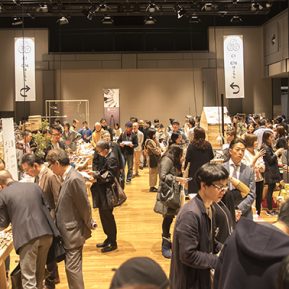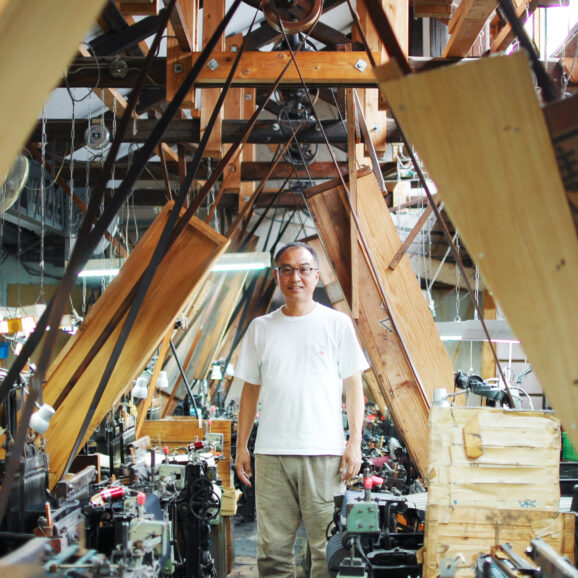TE TE TE Traders Expo 2017 Exhibitor Interviews (Part One)

– TE TE TE Traders Expo 2017
At 10:30 in the morning, a crowd of people had formed outside Spiral Hall to wait for the TE TE TE Traders Expo to open. At 11, people flowed into the venue as the doors opened. The venue was divided into three areas—Sections A, B, and C—lined with the 100 exhibitors’ booths. An average of 1,000 buyers a day attended TE TE TE Traders Expo 2017. In accordance with the event’s philosophy of linking the creator, conveyor, and user, many visitors could be seen going beyond simple business deals and listening intently to exhibitors talking about the background of their creative process.
– Local regions and handicrafts
– Rebuilding a 600-year history

Colorful Japanese paper not used in “Yamaga Toro” lanterns creates a product that fits in modern living spaces.
“Yamaga Toro” are lanterns crafted from Japanese paper, passed down for 600 years. They are an indispensable part of a shrine festival in the city of Yamaga in Kumamoto prefecture. The form of a metal hanging lantern is created with Japanese paper, then placed on the heads of female dancers. It is one of the best-known crafts representing the everyday culture of Yamaga. TÔRÔ is a mobile in a stand, created with nothing but handmade Japanese paper and a small amount of glue. The hand-crafted creation sways lightly and gently in the breeze. With no margin or overlap for the glue, a traditional technique is used to create beautiful seams using just the thickness of the paper for a texture not found in most Japanese paper crafts.

Hirotaka Nakashima, the producer and lantern maker.
“Ever since the Yamaga Toro was designated as a traditional craft by the national government in 2012, we had many discussions with local craftspeople, sales and marketing people, and producers and designers from inside and outside the prefecture. After countless prototypes, I’m confident that we were able to achieve our goal of creating something new through the use of traditional techniques. It finally became a real product last year, and it’s making its debut at this TE TE TE Traders Expo. I’m hoping the product will be a way for people to learn about life in Yamaga and our traditional culture.” (Hirotaka Nakashima, [Yamaga Toro Shop Nakashima])
[Yamanote]
>> http://yamaga-yamanote.com
– Japanese candles born from lacquer trees
!["From where we are in Noto, I want to convey the benefits of handicrafts that make use of the bounty of nature without any waste." (Hisashi Takazawa, [Takazawa Candle])](http://test-craft.oikaze.biz/wp/wp-content/uploads/2017/03/170316_sp_tetete2_1_05.jpg)
“From where we are in Noto, I want to convey the benefits of handicrafts that make use of the bounty of nature without any waste.” (Hisashi Takazawa, [Takazawa Candle])

Fruit of the lacquer tree. Takazawa Candle says they started harvesting lacquer tree fruit last year.
“Traditionally, Japanese candles have been made using wax from the fruit of the wax tree for ages. The wax tree and lacquer tree are both in the sumac family, and the fruits have very similar properties. This project got started in the hope that the lacquerware from Noto’s Wajima and Japanese candles could support each other and grow,” says Hisashi Takazawa of Takazawa Candle.
[Takazawa Candle]
>> https://www.takazawacandle.jp
– The fusion of two local industries
A new type of incense, “hibi” is a matchstick made of incense that does not require an ignition tool.

After striking a match, fragrance emanates from the matchstick made of incense and lasts for ten minutes.
!["The product is lit in a unique manner, but the incense is the main thing. We would like to offer people fragrance for their everyday lives." (Masafumi Sagayama, [Kobe Match Co., Ltd.])](http://test-craft.oikaze.biz/wp/wp-content/uploads/2017/03/170316_sp_tetete2_1_08.jpg)
“The product is lit in a unique manner, but the incense is the main thing. We would like to offer people fragrance for their everyday lives.” (Masafumi Sagayama, [Kobe Match Co., Ltd.])
[hibi]
>> http://hibi-jp.com/backstory.php
– Creating products and ties to society
– Braille-embossed paper items

Mini gift envelopes from the “dot” paper item series from torinoko
The design team “torinoko” presents the “dot” paper item series that makes use of Braille embossing produced by a support facility for the visually handicapped. The project, which creates envelopes and mini gift envelopes with Braille designs, also creates a framework to link the support facility for the visually handicapped with society at large through design.

Braille embossing uses two metal plates on top of each other to create text or designs with raised dots, then places paper between them and sends them through a roller press.
“Much of the demand for Braille embossing is related to books such as textbooks, and the work is concentrated in the period from winter to early spring. Demand falls off in other times, making it difficult to secure a steady flow of work. Someone at a support facility for the visually handicapped was looking for new sources of continuous work, even in small lots, to help improve worker skills. That led to the joint development of ‘dot.’ I hope people will enjoy the unique texture of Braille embossing.” (Yusuke Koyama, torinoko)

Braille textbooks produced at the support facility for the visually handicapped.
[torinoko]
>> http://shiratori5.wixsite.com/torinoko
– Communicating the culture and atmosphere of Yamagata

The design label “Yama no Katachi” presents handicraft products from all over Yamagata prefecture, ranging from ceramics and woodworking to bladesmithing and dyed fabric. Since its launch in 2014, Osamu Suto and Shuhei Shibayama, both residents of Yamagata, have worked with craftsmen to produce many prototypes and build the product lineup. “In Yamagata, making things is closely intertwined with everyday life. It would be great if we could communicate what that’s like through our handicrafts,” says the designer Shuhei Shibayama. “I would like for people to get to know the craftsmen of Yamagata—they’re quiet and serious, but all they want to do is make people happy. I’m convinced the handicrafts born in our beautiful but severe natural setting will touch the hearts of a lot of people.”
![[Yama no Katachi] designers Osamu Suto (left) and Shuhei Shibayama (right).](http://test-craft.oikaze.biz/wp/wp-content/uploads/2017/03/170316_sp_tetete2_1_13.jpg)
[Yama no Katachi] designers Osamu Suto (left) and Shuhei Shibayama (right).

Needlework amulets created with the theme “praying heart.” The amulet bags are produced by Soushi, which continues the tradition of Yamagata needlework. The amulet inside is by Katsunobu Yoshida, a designer living in Yamagata who also created the graphics for TE TE TE Traders Expo 2017.
“This is our first time exhibiting at TE TE TE Traders Expo, but meeting other exhibitors with similar values is very enjoyable. We would like to do something similar to TE TE TE someday, so I’d like to find like-minded people from our generation during the event.”
[Yama no Katachi]
>> http://yamanokatachi.jp
– TE TE TE for individual creators and craftsmen
– Traditional techniques that blend into everyday life

Dishes that reflect the characteristics of Koishiwara, which is also a center of folk crafts, adapted to modern eating habits.
The show featured many ceramics exhibits this year. [Keishuugama] from Koishiwara in Fukuoka prefecture presents “Japanese dishes that match the modern dinner table” by combining techniques from the long-established traditions of Takatori-yaki and Koishiwara-yaki. “While we use traditional techniques such as tobikanna (chattering) and hakeme (slip decoration), we aimed to create dishes that don’t give an overly traditional impression to people who use them.” (Naoko Kajiwara)
!["It would be nice if I could exhibit with my husband next time," says Naoko Kajiwara of [Keishuugama].](http://test-craft.oikaze.biz/wp/wp-content/uploads/2017/03/170316_sp_tetete2_1_16.jpg)
“It would be nice if I could exhibit with my husband next time,” says Naoko Kajiwara of [Keishuugama].
[Keishuugama]
>> https://keishuugama-koishiwara.jimdo.com
– Born in Denmark, raised in Japan

The products made by forming porcelain clay in plaster molds follow in the footsteps of modern Danish design.
Tatsuro Maeno, who creates his ceramics in the city of Chigasaki in Kanagawa prefecture, makes use of his experience studying design in Denmark and combines it with traditional Japanese ceramics techniques. The graceful forms and lively colors of his dishes and flower vases have a mysterious appeal that is neither Japanese nor Western.

The “Meoto Cup” series, with a theme based on the colors of France’s four seasons.
“It’s difficult to tell where my work comes from, so I tell buyers, ‘They’re born in Denmark and raised in Japan.’ The bright colors often get attention, and I’m happy that some people say they’re dishes, but they’re almost like decorative objects. Right now I’m doing everything from planning and design to production on my own, but at some point I’d like to collaborate with other ceramics-producing areas to build a large production system. There are many ceramics producers from all over Japan with various characteristics here at TE TE TE, so I’d like to find like-minded people I can work with now and in the future.”
[Tatsuro Maeno]
>> http://tatsuromaeno.blogspot.jp
Continued in Part Two >> TE TE TE Traders Expo 2017 Exhibitor Interviews (Part Two)
SPECIAL
TEXT BY YUJI YONEHARA
PHOTOGRAPHS BY MITSUYUKI NAKAJIMA
17.03.16 THU 23:27



